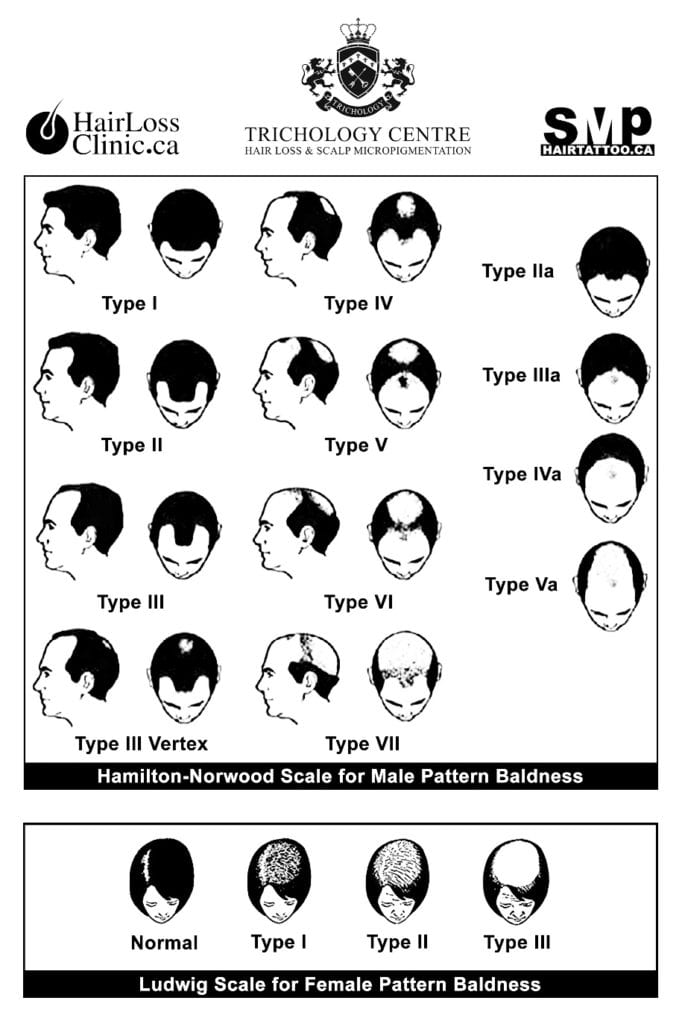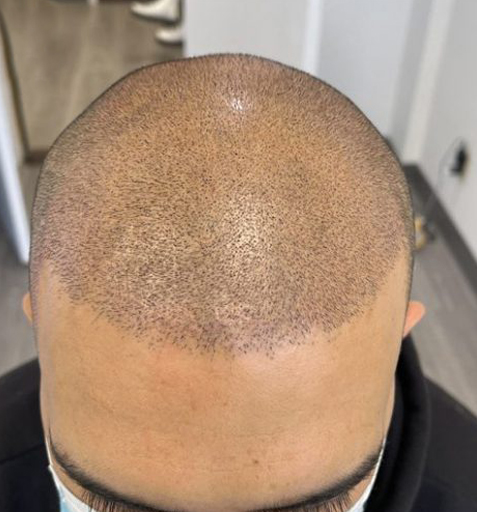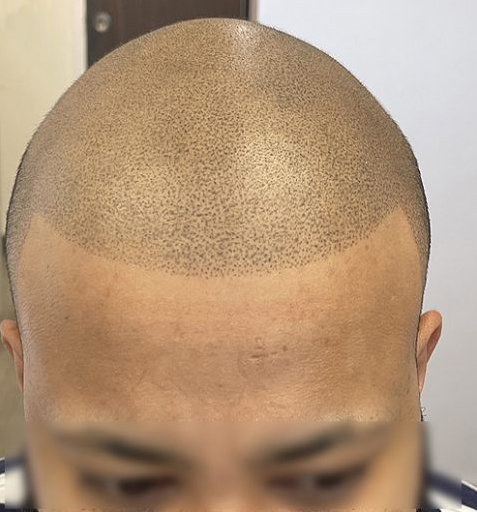
Table of Contents
Male pattern hair loss is a condition that affects many men. It usually begins with thinning hair and can progress over time. Early identification of hair loss is crucial. Monitoring the progress of hair loss helps in choosing the right treatment.
This guide will explain how to measure male pattern hair loss and explore treatment options.
Table of Contents
Male pattern hair loss is a hereditary condition. It typically starts with a receding hairline or thinning at the crown. Genetics and hormonal changes cause this condition. Hormonal changes, particularly the increase in DHT, shrink hair follicles over time. Men in their 20s or 30s often notice this type of hair loss. Hair loss progresses gradually and may lead to complete baldness.
Male pattern hair loss is common in men, especially in older age. Early stages show mild thinning, while later stages show more significant hair loss. The process is gradual, which allows for early intervention. Tracking changes in your hair can help in managing the condition.
Male pattern hair loss follows a predictable pattern of thinning and balding. Proper measurement helps determine the stage and guide treatment options.
The hairline often recedes first. A receding hairline is a clear sign of male pattern hair loss. Look at your temples to check for thinning. A noticeable difference in the shape of the hairline can indicate hair loss.
Regularly examine your hairline in front of a mirror. Compare recent photos to older ones to detect changes. Early detection allows for quicker action and better results with treatments.
The crown often shows the next signs of thinning. Look at the top of your head in a mirror to check for bald spots. A thinning crown indicates progression in hair loss.
Ask a friend for help or use a second mirror to check the back of your head. The crown often thins slowly, making it harder to detect in the early stages. Tracking changes at the crown helps you monitor the progress of your hair loss.
Hair shedding is normal. Losing about 50 to 100 hairs per day is typical. Notice if the shedding increases beyond this amount. Excessive shedding may indicate a problem with hair growth.
Track the hair you shed every day. If the shedding becomes noticeable, it may be time to start using treatments. Count how many hairs you find in the shower or on your pillow to track the amount.
The Norwood scale measures the stages of male pattern hair loss. It helps you assess the severity of your hair loss. The scale ranges from Stage 1, with little to no hair loss, to Stage 7, with extensive baldness.
Compare your hair loss to the scale regularly. The scale will help you monitor your progress over time. Using the Norwood scale makes it easier to determine which treatment is suitable for your condition.
Male pattern hair loss, also known as androgenetic alopecia, is a condition that affects many men over time. While genetics and hormones play the most significant role, various other factors can contribute to or accelerate the condition. Understanding these causes is essential for early intervention and managing hair loss effectively. Let’s discuss the leading causes of male pattern hair loss in greater depth.
Hormonal imbalance, particularly an increase in dihydrotestosterone (DHT), is a key cause of male pattern hair loss. DHT binds to hair follicles, causing them to shrink, leading to thinner hair. Genetics also play a role, making men with a family history more susceptible to early hair loss.
Chronic stress can lead to hair loss through telogen effluvium, where stress pushes more hair follicles into the resting phase, causing excessive shedding. While this shedding is typically temporary, prolonged stress can worsen male pattern hair loss by disrupting hormonal balance. Stress management techniques can help reduce its effects on hair.
As men age, hair growth naturally slows, and hair follicles shrink, leading to thinner, weaker hair. This process often results in more noticeable hair loss, especially in men over 50. While age-related hair loss is inevitable, its progression varies based on genetics, starting with mild thinning and potentially leading to severe baldness.
Alopecia areata is an autoimmune disorder where the immune system attacks healthy hair follicles, causing round patches of hair loss, usually on the scalp. While it’s not directly linked to male pattern hair loss, it can exacerbate or trigger it, particularly in younger men. Genetics and environmental factors contribute to alopecia areata, with treatments like corticosteroid injections and immunosuppressive therapies available.
Certain medical conditions, such as thyroid disorders, diabetes, and autoimmune diseases like lupus, can disrupt the hair growth cycle and exacerbate male pattern hair loss. These conditions often cause hormonal imbalances, leading to thinning and hair loss. Managing the underlying disease, like regulating thyroid or blood sugar levels, can help restore hair growth.
Radiation therapy, commonly used in cancer treatment, can damage hair follicles, leading to significant hair loss in the treated areas. The extent of loss depends on the radiation dose and exposure area. While hair loss is typically temporary, regrowth may result in thinner or altered texture. In some cases, hair may not regrow, and alternatives like wigs or hair transplants may be considered.
Proper nutrition is crucial for healthy hair growth. Deficiencies in key nutrients can lead to hair thinning and loss. Common deficiencies include:
A balanced diet rich in these nutrients can help prevent or reduce hair loss, and supplements may be recommended to address specific deficiencies.
Anemia, especially iron-deficiency anemia, can lead to hair loss by reducing oxygen and nutrient supply to hair follicles, weakening them and causing thinning and shedding. Anemia may result from poor diet, blood loss, or underlying health issues. Treating anemia with iron-rich foods or supplements can improve hair health, but it’s important to consult a healthcare provider for proper diagnosis and treatment.
Male pattern hair loss (MPHL), typically progresses predictably. Recognizing the early symptoms is key to managing the condition effectively. Here are the most common signs of male pattern hair loss:
The most common early symptom of male pattern hair loss is a receding hairline. It often begins at the temples and gradually moves backwards, creating an “M” shape. Over time, this recession deepens, and the forehead may appear larger as the hairline continues to move back.
Thinning at the crown, or the top of the head is another hallmark sign of MPHL. It starts as a small patch of thinning and gradually expands. The thinning area may become more visible, and in some cases, the scalp becomes noticeable through the remaining hair. This is often one of the earliest signs, particularly in men with a family history of hair loss.
Normal hair shedding occurs daily, but men experiencing male pattern hair loss may notice an increase in the amount of hair shed. This could manifest as more hair on your pillow, comb, or shower drain. As the follicles shrink due to DHT (dihydrotestosterone), hair enters the resting (telogen) phase of the growth cycle more quickly, leading to noticeable hair loss.
As hair follicles become smaller over time, the hair that grows from them becomes thinner, weaker, and finer. This process, known as follicular miniaturization, means the individual hair strands may no longer appear as thick or strong as before. The texture of your hair may also change, becoming less dense and appearing more limp.
In the later stages of male pattern hair loss, bald spots may develop, particularly at the crown or vertex of the scalp. These spots may expand over time as hair continues to thin. In advanced stages, these spots may merge, resulting in larger areas of baldness on the top of the head, while the sides and back of the hair often remain unaffected.
In some cases, male pattern hair loss leads to overall thinning rather than distinct bald spots. This type of thinning can affect the entire scalp, with no specific areas of noticeable recession. The hair may appear less dense, and the scalp might become more visible, especially under certain lighting conditions.
If you are a man living in Toronto or the Greater Toronto Area and believe you are suffering from male hair loss, then using the Norwood Scale is suitable to measure your hair loss level.
The Norwood Scale has seven stages, ranging from minor hair loss and no hair loss to complete baldness.

Hair loss treatments include medications, lifestyle changes, and medical procedures. The right option depends on the cause and severity of your condition.
Minoxidil is a topical treatment used to slow hair loss. It stimulates hair growth by increasing blood flow to the scalp. Minoxidil is available over the counter and is easy to use.
Apply Minoxidil directly to the scalp. Use it regularly for several months to see noticeable results. Some men experience side effects like scalp irritation, but the benefits often outweigh these minor issues.
Finasteride is an oral medication that helps reduce hair loss. It works by blocking DHT, the hormone responsible for shrinking hair follicles. Finasteride is available by prescription and can be used long-term.
Take Finasteride daily for the best results. It is effective for slowing hair loss and promoting regrowth. Side effects are rare but may include sexual dysfunction in some men. Consult a doctor before starting Finasteride to understand its risks and benefits.
Hair transplants offer a permanent solution for severe hair loss. The procedure involves transplanting healthy hair follicles to thinning or bald areas. Hair transplants provide natural-looking, long-lasting results.
The procedure requires surgery, and recovery may take a few weeks. Although hair transplants are expensive, they offer permanent results. Talk to a hair specialist to determine if this is the right option for you.
A healthy diet supports hair growth. Include vitamins, minerals, and proteins to nourish your hair. Stress reduction is also important for maintaining healthy hair. Regular exercise promotes good circulation, which supports healthy hair follicles.
Avoid excessive heat and harsh treatments on your hair. Gentle care helps prevent further damage. Small lifestyle changes can significantly impact the health and appearance of your hair.
Early detection of male pattern hair loss is essential for effective treatment. Monitoring your hairline, crown, and shedding, and using tools like the Norwood scale will help you track your progress. Treatments such as Minoxidil and Finasteride, or even hair transplants, can slow or reverse hair loss.
A healthy lifestyle can also play a role in maintaining hair health. Start taking action today to manage your hair loss effectively.
Male pattern hair loss is caused by genetics and hormonal changes, particularly an increase in DHT.
Preventing male pattern hair loss is difficult, but early treatment can slow it down. Using Minoxidil or Finasteride may help.
It may take 3 to 6 months to see noticeable results with Minoxidil. Consistent use is important.
Some men experience sexual side effects, such as reduced libido or erectile dysfunction, but these are rare.
Yes, hair transplants offer permanent results as the transplanted follicles continue to grow in their new location.






© 2024 HAIRTATTOO.CA | Scalp Micropigmentation & Trichology Centre
